| 1 | One of Thailand’s most common |
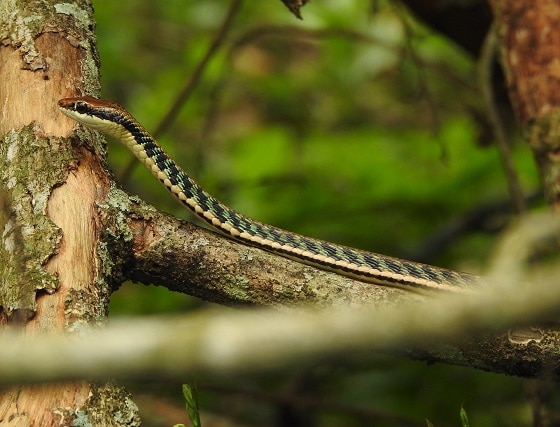
If you visit Thailand or Singapore, your chances of meeting a king cobra are pretty low. They tend to stick to scenic forests, only rarely entering towns and cities. Instead, your chances are far higher of meeting the painted bronzeback (Dendrelaphis pictus), a harmless 100cm species which is abundant all over southeast Asia.
This is an incredibly thin species, which mainly preys on frogs and geckos. Painted bronzebacks are branch-dwellers, also appearing on green bushes in rural villages or even towns. With their feather light bodies, they easily rest on the lightest, most fragile branches, which thicker snakes would cause to snap, therefore plummeting to their doom.
Painted bronzebacks are a fast and inquisitive snake. They’re constantly flecking their red tongues, hoping to catch a scent particle which guides them to their next task. This is also a confident snake, which knows that it can vanish to the safety of upper branches the moment humans attempt to touch them.
Catching a painted bronzeback is incredibly difficult, as their nimble body will probably slip through your outstretched fingers the moment you think you’ve succeeded. Even snapping a photo is tricky, as they can vanish from the side of a camera frame in mere milliseconds, the moment you press down. This snake is so intimate with upper tree branches that they’re like an extension of its body.
| 2 | Your handy ID guide |
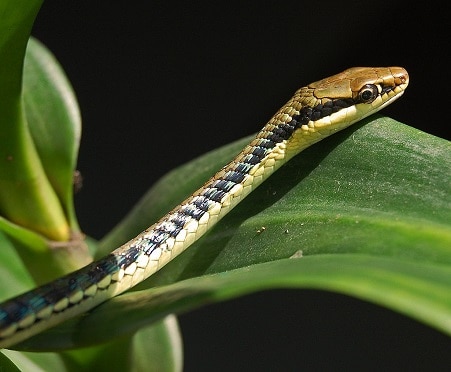
Painted bronzebacks are fairly easy to recognise. First is their extremely thin body, the exact opposite of a blood python. If stationary, they could easily be mistaken for a dry tree branch, particularly if viewed from below.
Painted bronzebacks have a round pupil, and a red tongue with a black tip. Their patterns are arranged in long stripes of colour, which continue from head to tail. The namesake bronze back starts as a skull cap, which continues all the way down their spine. On the flanks, the next section begins, a jet black stripe which continues all the way to the tail. Lower on the flanks is a cream coloured stripe, which is then bordered by a much thinner black stripe. This second black stripe only begins at the chest downwards.
Finally, there’s the belly, which is purely cream coloured, with no patterns whatsoever. On the chest, painted bronzebacks have subtle blue patches. The thickest black stripe ends directly at the eye, the two fusing together. Painted bronzebacks reach a maximum of 125cm.
| 3 | An expert branch jumper |
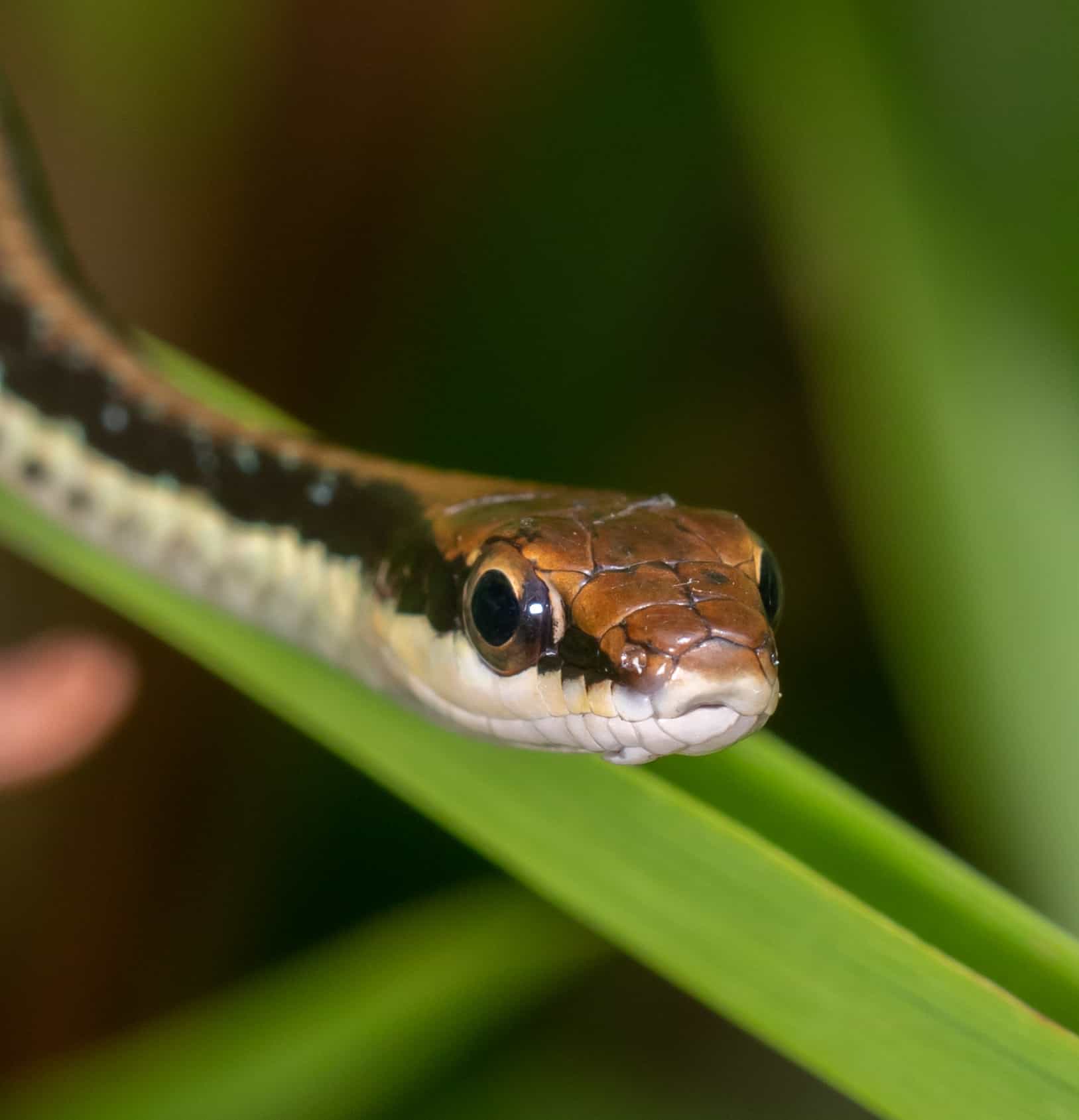
The Dendrelaphis genus is most closely related to the flying snakes (Chrysopelea), which have 5 members, and are famous for their ability to glide between tree branches, sometimes up 40 metres. Golden tree snakes are the most common flying species in Thailand. Painted bronzebacks are unable to fly, but they are highly proficient jumpers, crossing sheer gaps between branches. It’s believed that their behaviour provided the evolutionary base for flying snakes, which refined the jumping traits into flying.
When approaching a gap, Dendrelaphis pictus throws its head upwards to perform a sudden vertical loop. It accelerates upwards along this loop, becoming airborne via massive propulsive force. They can easily cross gaps that exceed their own body length.
Other traits, such as weaving along ultra thin branches and effortlessly climbing trees, are similar between the species. Painted bronzebacks also have a slightly concave belly, like an upside down U, which it uses for gripping while climbing. In flying snakes, this is used to capture air pockets. Golden flying snakes take this further by extending their ribcages sideways, to capture even more air. Dendrelaphis pictus lacks this power, but can shift the bones in its head to add bulk and size, to intimidate predators.
| 4 | Flashes enemies with dazzling blue |
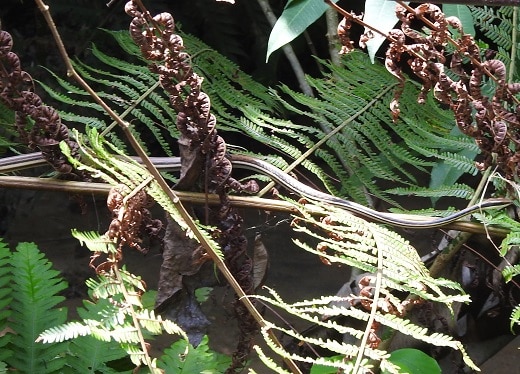
Before human civilisation existed, when the Thai landscape was still untouched and wild, the painted bronzeback is believed to have been a forest edge species, rather than a deep forest dweller. Nowadays, this preference translates well to leafy rural villages with many clumps of trees. Painted bronzebacks cope excellently with semi-degraded areas and eagerly curl around roofs, wooden bridges, and lampposts. You can find them on brick walls, stone tiles of patios, and metallic fences. They may even lurk in your garden beneath bricks or spare tiles.
Be careful though, as if you disturb a painted bronzeback, they may flash you. Specifically, they may stretch their chest, revealing interstitial skin between the scales, which has an electric blue colour.
This is probably designed for intimidating predators, and when combined with the black, cream and the juicy red tongue, the dazzling blue might just convince birds to back off. Small blue patches are also noticeable while they’re calm, and this is a variable feature in painted bronzebacks, as some have far more extensive blue patches than others.
| 5 | The most common bronzeback member |
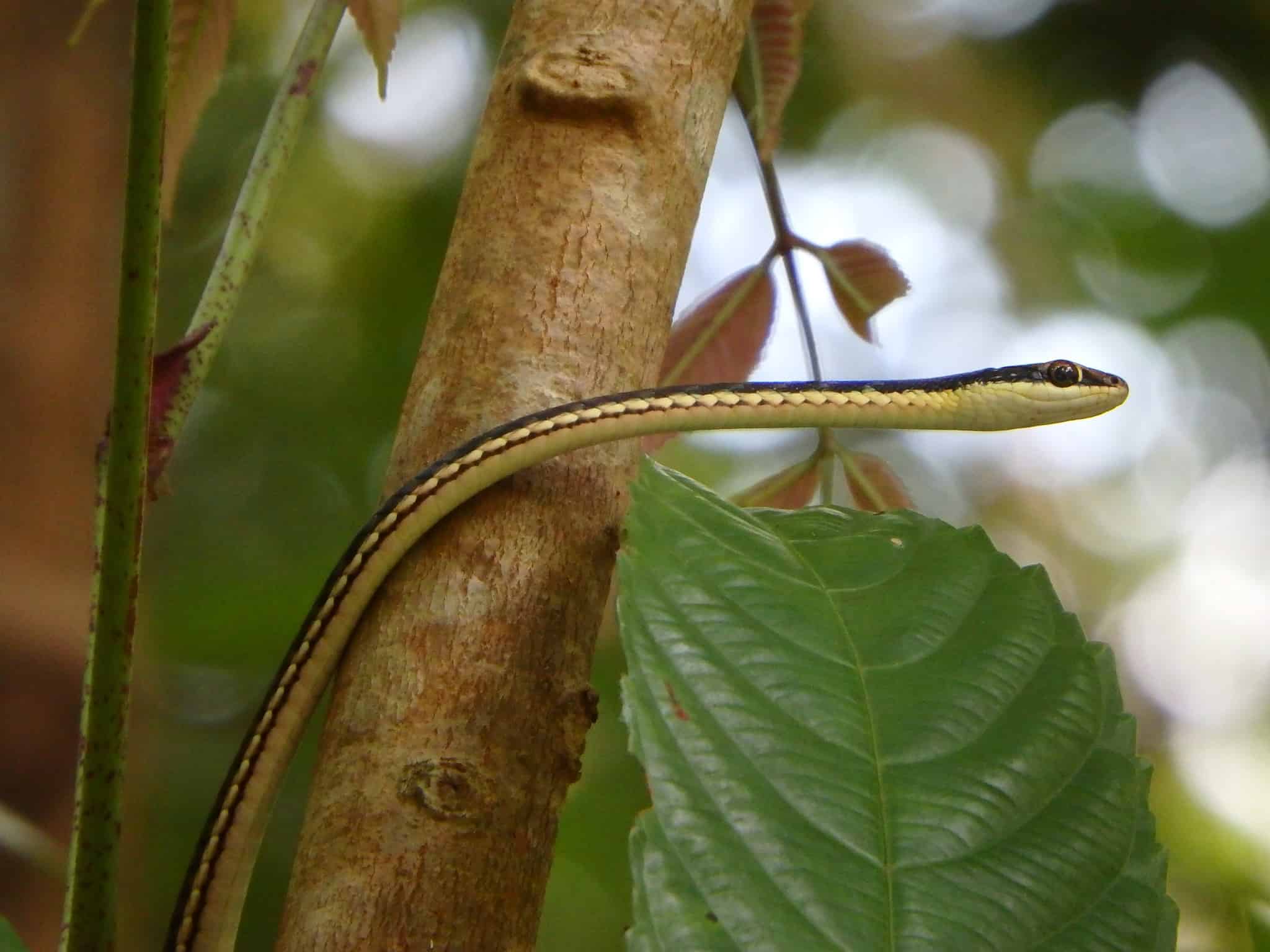
Painted bronzebacks belong to the Dendrelaphis genus, which has over 40 members. All live in southeast Asia and the Indian subcontinent, with a sole exception: the green tree snake of Australia (Dendrelaphis punctatus). India’s main species is the common bronzeback (Dendrelaphis tristis), but overall, painted bronzebacks are easily the most widespread member.
Their territory begins in extreme eastern India, and continues through Myanmar, Laos, Thailand, Cambodia, and Vietnam. They’re then found in peninsular Malaysia, and Singapore, where there’s probably the highest abundance of sightings of anywhere. Painted bronzebacks also inhabit the whole islands of Sumatra and Java. They’re common in Jakarta, and another extreme hotspot is the IPB University campus in west Java (see this handy map).
Painted bronzebacks aren’t found in the Philippines. They were originally believed to be, but these colonies were switched to a new species based on scientific analysis: Maren’s bronzeback. This is the painted bronzeback’s closest relative, with a genetic distance of just 1.6%. Likewise, they’re missing from Papua New Guinea, and Indonesian Guinea in the western half. The easternmost point that painted bronzebacks reach is the Indonesian island of Lombok.
| 6 | Diet: frogs and geckos |
Painted bronzebacks are a classic branch dangler. Their tail is not only long and thin, but prehensile, allowing them to anchor securely on a tree limb, and lower their body through thin air. Dendrelaphis pictus is capable of both grabbing and swallowing prey in mid air, with most of their upper body floating. They gradually chew forward on a frog’s body until their toes vanish, usually starting with the head. The swallowing process varies; one white-lip frog took an hour to be swallowed, while an Asian rice frog was swallowed in ten minutes.
The painted bronzeback’s diet mainly consists of frogs and reptiles, particularly geckos. Several species are confirmed, some since 2015:
- White lip frog (Hydrophylax raniceps).
- Brooke’s house gecko (Hemidactylus brookii).
- Copper-cheeked frog (Rana chalconata).
- Asian rice frog (Fejervarya limnocharis).
- Common house gecko (Hemidactylus frenatus).
- Common tree frog (Polypedates leucomystax).
Being branch dwellers, and eagerly skirting around spindly branches without considering their own safety, painted bronzebacks are easy pickings for bird predators. They’ve been photographed hooked in the talons of a crested serpent eagle, resting proudly after its catch. Then there’s fellow snakes…
| 7 | Confirmed snake predators |
There’s so many painted bronzebacks dashing around Thailand that fellow snakes would be foolish not to prey on them. One confirmed predator is the gold-ringed catsnake, a distinctive yellow-black snake which drapes itself over branches. In December 2015, scientists spotted a catsnake in the compound of a private garden, adjacent to the Sama Jaya Nature Reserve of eastern Malaysia. The catsnake was resting on a tree 1.5m above ground, and as it had a large abdominal bulge, they kept it under observation overnight. The next morning, it regurgitated a whole painted bronzeback, which measured 80cm, and was folded in half.
Another tale took place in Ngargorejo, central Java, in April 2017. A Javan spitting cobra (Naja sputatrix) was spotted on a dry creek bred, adjacent to a rice fields and a small wooded area. The cobra had a partially consumed painted bronzeback hanging out of its mouth. Javan spitting cobras normally flee when confronted, but this snake was eating and unable to. So it fully regurgitated its bronzeback prey, and fled at high speeds into dry bush.
The scientists returned an hour later to find the painted bronzeback still lying there. It measured 96cm, which was actually longer than the spitting cobra at an estimated 80-85cm. Painted bronzebacks are so thin that they can be swallowed by snakes shorter than themselves.
| 8 | Tricky to feed in captivity |
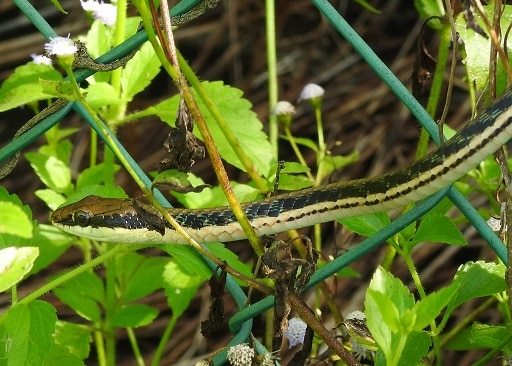
Painted bronzebacks aren’t the most common snakes in captivity, and you won’t find one in your local pet shop. However, they’re fairly easy to find for a determined reptile enthusiast. Keeping them is another story. Painted bronzebacks rarely eat rodents in the wild, and will only begin eating them with much persuasion. Keepers have tried scenting rodents with American green tree frogs, to hijack their taste buds. Some took months of persuasion.
According to this keeper, 32C was optimal for the enclosure at the warm, basking end, and 24C at the cool end. Below this they started to noticeably suffer. This is a Thai snake, not a European adder which can easily cope below 20C.
The keeper found that painted bronzebacks loved to be sprayed with warm water. Even in their timid early days, they would emerge from their enclosure dens to enjoy this spraying, licking droplets of the walls. From then on, he sprayed them once per day. Initially, the bronzebacks were nervous and shied away from contact. Over time, this lessened, but the keeper still recommended not touching them regularly, unlike a boa constrictor which you can regularly pick up.
| 9 | Other bronzeback species |
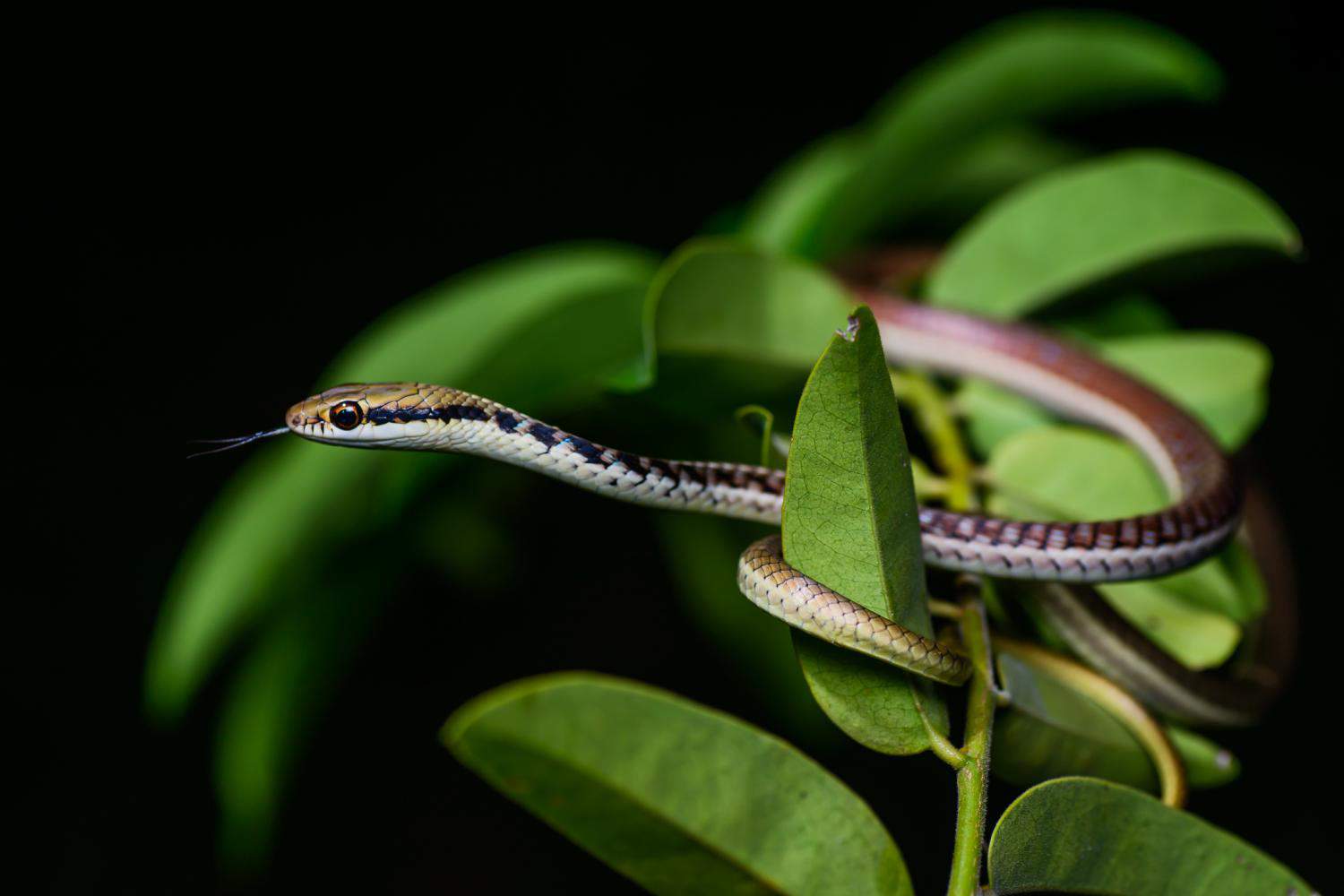
Painted bronzebacks have numerous fellow Dendrelaphis members which they can easily be confused with. Singapore has 6 bronzeback species, while Thailand has at least 11. In both countries, painted bronzebacks are easily the most common species. Some such as the elegant bronzeback (Dendrelaphis formosus) could never be confused, as they have even livelier colours. A few only exist in narrow regions, like Kopstein’s bronzeback and Haas’ bronzeback, are found only in far southern Thailand.
The Burmese bronzeback (Dendrelaphis subocularis) is one of the most widespread after the painted. It’s found in all of Thailand except the far south, and looks superficially similar, with a brown back, bordered by a black line and then a creamy belly. The key ID sign is that Burmese bronzebacks (also called mountain bronzebacks) have a thin black line bordering each individual scale, both on the brown and creamy sections. This gives them a messier look, while painted bronzebacks look “clean”. They also have a blacker tongue.
| 10 | Captivity reports |
Painted bronzebacks are egg layers, in batches of 3-8. These are laid in tree hollows, and neonates hatch at just 8-12cm long. At birth, their heads are far more distinct from their necks. Their eggs are highly elongated, and about 1 inch long. Female adults are slightly longer than males, but not by colossal proportions like a Wagler’s pitviper.
The keeper above once had a female which laid 4 eggs. At birth they were too tiny to feed on mice, but he secured a steady supply of tiny frogs from his local pet shop. The neonates gobbled them up eagerly, and grew steadily from then on, after which he successfully transferred them to pinkie mice.
Another observation was that at all ages, painted bronzebacks were a shy feeder, and would only swallow their meals when the keeper had left. Painted bronzebacks have a high metabolism a well. Unlike a blood python, which can go months without eating, the captive bronzebacks fed every 3-7 days.
